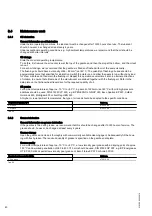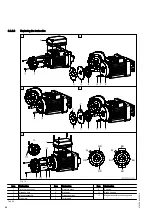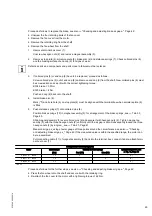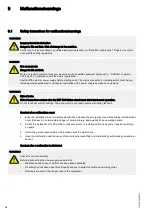
Anybody who identifies an immediate danger of personal injury must actuate the emergency stop without delay.
This also applies if damage occurs to parts of machinery or equipment which makes an immediate stoppage nec‐
essary.
If the installation has been stopped by an emergency stop due to safety-relevant defects, it must be secured
against being returned to operation until an experienced technician is satisfied that the cause of the hazard situa‐
tion has been eliminated and that operation of the installation is possible without any hazard.
Before starting work:
● Wear protective equipment.
● Ensure that nobody is present in the danger zone of the equipment.
7.2.2
Function checks
Instructions for users where the BGV D06 accident prevention regulations apply:
In accordance with BGV D06, the crane operator must also check operation of the emergency-stop device when
he or she starts work. This does not apply to slipping clutches used as an emergency-stop device which do not
need to be checked when work begins (BGV D06, Section 30).
The following main functions of the machine must be checked before work begins:
● Emergency-stop device,
● Check control cable and control pendant housing for damage,
● Function of the brake.
7.3
Operation
7.3.1
General
WARNING
Overload
Danger to life and limb.
Higher loads than those specified on the load capacity plate must not be handled.
–
Do not exceed the maximum permissible load capacity of the hoist.
–
Only use load handling attachments which are adequately dimensioned.
–
Only use load handling attachments for their intended purpose.
Important information for operation
Observe the following during operation:
Safety during operation
–
Take the installation out of service immediately if functional defects or irregularities are detected.
–
The operator is obliged to check the DRF 200 friction wheel travel drive for any visible damage at least once
per shift and to report any damage immediately.
–
Do not render safety devices inoperative.
–
Do not approach limit stops in normal operation, e.g.: emergency-stop devices (emergency limit switches),
emergency limit stop devices (slipping clutch or emergency limit switch), track and limit buffers to stop move‐
ment of the crab or crane, hook assembly or bottom block against limit stops. Continuously approaching
these limits may result in severe damage.
–
Do not reach into rotating parts and maintain a sufficient safety distance to prevent clothing, parts of the
body or hair becoming entangled.
214
39
5 44/120
914
35
Содержание DRF 200
Страница 51: ...214 395 44 120914 51...
















































